Roman Warfare › Ancient Greek Warfare » Ancient origins
Articles and Definitions › Contents
- Roman Warfare › Antique Origins
- Ancient Greek Warfare › Ancient History
Ancient civilizations › Historical and archaeological sites
Roman Warfare › Antique Origins
Definition and Origins
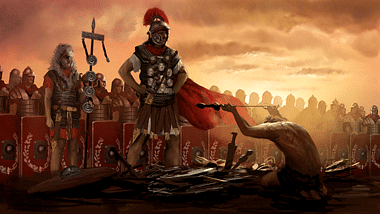
Over many centuries and across many territories the Romans were able to win an astonishing number of military victories and their success was due to several important factors. Italy was a peninsula not easily attacked, there was a huge pool of fighting men to draw upon, a disciplined and innovative army, a centralised command and line of supply, expert engineers, effective diplomacy through a network of allies, and an inclusive approach to conquered peoples which allowed for the strengthening and broadening of the Roman power and logistical bases. Further, her allies not only supplied, equipped and paid for additional men but they also supplied vital materials such as grain and ships. On top of all this Rome was more or less in a continuous state of war or readiness for it and believed absolutely in the necessity of defending and imposing on others what she firmly believed was her cultural superiority.
READY FOR WAR
In Roman culture martial values were highly regarded and war was a source of prestige for the ruling class where career progression came from successful military endeavour. Indeed, conflict in Roman culture went right back to the origins of Rome and the mythical battle between Romulus and Remus. This thirst for war combined with what Polybius stated as 'inexhaustible resources in supplies and men' meant that Rome would become a terrible and formidable foe for the peoples of the Mediterranean and beyond. However, there were also times when Romans more than met their match - such as against Carthage, Parthia and the Germanic tribes - or when Romans fought Romans such as the civil wars between Julius Caesarand Pompey or Vitellius against Otho, and then the carnage of ancient warfare reached even greater proportions.
THE ROMAN LEGIONS WERE A WELL-TRAINED AND HIGHLY DISCIPLINED FIGHTING MACHINE.
In the Republic declaration of war was in theory in the hands of the people but in practice the decision to raise arms was decided by the Senate. From Augustus onwards the decision became the Emperor's alone. Once military action was decided upon certain rituals had to be performed such as sacrifices and divination to find favourable omens and the supplicatio rite where prayers and offerings were offered at each of the major gods' temples.
STRUCTURE & COMMAND OF THE ROMAN ARMY
The Roman army left its mark wherever it went, creating roads, depots and bases. Involving men from the age of 16 to 60, it was a conduit for the Romanisation of conquered lands and one of the main carriers of foreign cultural influence back on Rome itself.
Either or both of the two consuls conducted war on the battlefield although command could also rest in the hands of a praetor or pro-magistrate with imperium who, otherwise, commanded individual legions. If both consuls were present they rotated command each day. In the Imperial period the emperor himself could lead the army. Tribunes and Legates could also command a legion or subsidiary detachments and each maniple of 200 men was commanded by a prior and posterior centurion (the former being senior), resulting in around 60 centurions per legion.

Roman Army Reenactment
In the early Republican period troop formation followed the example of the Greek phalanx but from the 3rd century BCE to the 1st century BCE the tactics for infantry deployment changed. The largest unit in the Roman army was the legion of 4,200 men divided into 30 divisions or maniples which were now each deployed in three lines ( hastati, principes, and triarii who were the veterans) arranged as in a checkerboard ( quincunx ). Another 800 to 1200 light-armed soldiers ( velites ), often from Rome's allies, took position in front of the legion with 300 cavalry positioned in support. These two groups were used as a protective screen for the heavy infantry legions and they also harried the enemy from the flanks when the enemy met the legions head on. In the 1st century BCE both disappeared from the army but the cavalry did make a comeback in the Imperial period.Specialist mercenary troops with skills the Romans lacked might also be employed such as Cretan archers and slingers from Rhodes.
The maniples were mobile, disciplined in their close formation and they could rotate their engagement with the enemy to allow fresh troops into the battle. Manoeuvrability was also aided by the adoption of lighter weaponry - the short sword or gladius Hispaniensis, the pilum javelin instead of the traditional heavy spear, and the central-handled, concave shield or scutum. In addition, it came to be recognised that terrain could be an important factor in aiding or hindering troop movements. Troops were also trained to use these weapons well and to carry out complicated battle manoeuvres, although the duration and intensity of training was very much down to individual commanders.
From 100 BCE (or perhaps even earlier) the maniple was abandoned and instead a legion was divided into 10 cohorts of 4-500 men which would remain the basic Roman tactical unit. In this period, legions also took on permanent names and identities and were equipped by the state. In 167 BCE there were 8 legions but by 50 BCE this number had risen to around 15 legions. Augustus in c. 31 BCE created for the first time a permanent and fully professional army with a central command and logistics structure resulting in a permanent force of 300,000 men paving the way for the huge armies of later centuries when there were 25-30 legions across the empire. In 6 CE the emperor also created a treasury specifically for the military ( aerarium militare ) which was funded by taxes and allowed for a system of retirement benefits. Another of Augustus' policies was to ensure loyalty by carefully restricting positions of command to the Imperial clique.
MOTIVATING THE TROOPS
All troops swore an oath of allegiance, the sacramentum, to the emperor himself. This was a major factor in ensuring loyalty but it also encouraged the discipline - disciplina militaris - for which the Roman armed forces had become famous since the early Republic and which was directly responsible for many a victory on the battlefield. Discipline was further ensured through a system of rewards and punishments. Soldiers could receive distinctions, money, booty, and promotion for displaying courage and initiative. However, a lack of rewards and excessively long service without leave could cause grievances which sometimes developed into mutiny. Punishment came in many forms and could be implemented due to mutinous dissent but also a lack of courage in battle. In particular, the punishment of decimation was usually reserved for cowardice, for example, abandoning the body of a fallen commander. This involved lots being drawn and every tenth man being clubbed to death by the other nine.Other punishments included loss of booty, pay or rank, flogging, dishonourable discharge, being sold into slavery or even execution. The principle was that by breaking one's oath of allegiance, one lost all of one's rights.
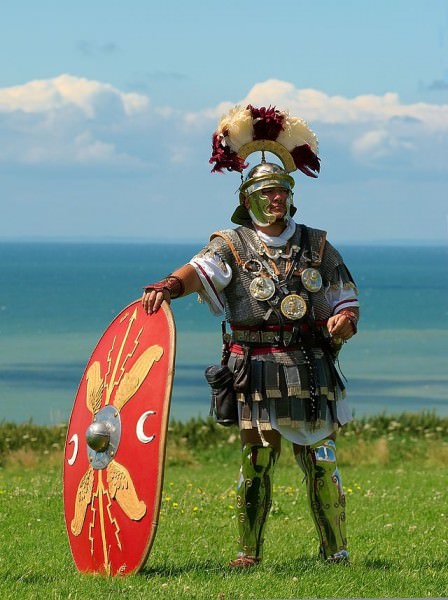
Centurion
STRATEGIES
Julius Caesar 's Commentaries on the Gallic War describes the great commander's attention to logistics, decisiveness and appearance of confidence and their positive effect on the morale of the troops. He also records the importance of innovation, patriotism, discipline and fortune. In addition, a commander could greatly strengthen his chances of success before the battle by gathering military intelligence of the enemy from captives, dissenters and deserters. Commanders could hold (as Caesar himself did) a consilium or war council with their officers to present and discuss strategies for attack and utilise the experience of veteran campaigners. It would be a combination of all of these factors that would ensure Roman military dominance for centuries. There were important defeats along the way but it is interesting to observe that commanders often escaped repercussions for their military incompetence and it was usually the soldiers who bore the blame for defeat.
Roman commanders generally preferred an aggressive and full-frontal attack (albeit preceded by suitable reconnaissance by a scouting vanguard of exploratores troops) whilst terror and revenge tactics were also used to subdue local populations, a strategy mixed with clementia - accepting hostages and promises of peace from the enemy. From the 1st century BCE there was an increase in the use of battlefield fortifications and entrenchments and sieges. From the 3rd century CE defence of the empire's borders became a priority and led to the fortification of cities and a more mobile deployment of smaller units of troops ( vexillationes ) of between 500 and 1,000 men. This was largely due to enemy forces being wary of full-on attacks with the formidable Romans and so preferring guerrilla tactics. Julius Caesar was also a great proponent of sieges and they did present certain advantages. An opposing force could be severely reduced in one blow, the local population could be suitably terrorised into accepting Rome as their new master and a readymade stronghold could be acquired if successful.
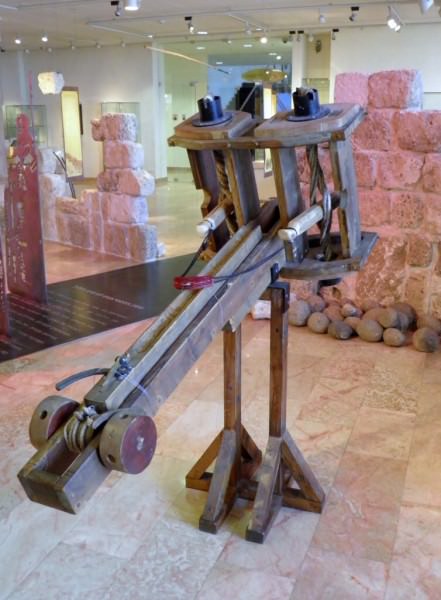
Roman Ballista Reconstruction
SIEGES
In a typical siege forces were sent ahead to surround the settlement to be attacked and prevent anyone escaping. The main force would build a fortified camp out of missile range from the city and preferably on high ground, which provided a good vantage point to observe inside the settlement and pick out key targets such as water supply. Once the attack began, the defender's walls could be overcome by building a ramp up against them using trees, earth and rocks. Whilst this was being done the attackers would be protected by temporary covers and a covering fire from batteries of torsion catapults, bolt-firers, stone-throwers and archers. The defenders could try to extend the height of the wall section under attack and even add towers. The attackers could also attack the walls with heavy rams (suspended on a framework) and also use siege towers.The defenders threw everything they could down on the attackers such as burning oil, burning pieces of wood and rocks and they could also try to undermine the siege ramps and towers by tunnelling, a technique the attackers might also employ to undermine the defensive walls. Generally, once conquered, only the women and children could hope to survive as an example had to be set of the futility of prolonged resistance.
LOGISTICS
The Imperial army on the march was first and foremost well-ordered. Besides legionaries, the troop could include cavalry, archers, auxiliaries, artillery, rams, standard bearers, trumpeters, servants, baggage mules, blacksmiths, engineers, surveyors, and road builders. When the army reached its destination it made a fortified camp and the logistical skills of the Romans meant that they could be supplied independent of the local territory, especially in terms of food. Once supplies had reached a camp they were stored in purpose-built warehouse ( horrea ) which, constructed on stilts and well ventilated, better preserved perishable goods. Food stores were protected against their number one enemy - the black rat - by using cats, which were, for the same reason, also used on ships.
One particular innovation of the Imperial period was the introduction of doctors ( medici ) and medical assistants ( capsarii ), who were attached to most military units. There were even army hospitals ( valetudinarium ) within the fortified camps.
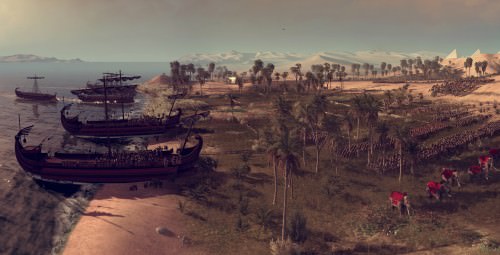
Naval Landing
NAVAL WARFARE
Roman naval tactics differed little from the methods employed by the Greeks. Vessels were propelled by rowers and sail to transport troops and in naval battles the vessels became battering rams using their bronze-wrapped rams fixed on the ship's prow. Rome had employed naval vessels from the early Republic but it was in 260 BCE that they built their first significant navy, a fleet of 100 quinqueremes and 20 triremes, in response to the threat from Carthage. Quinqueremes, with five banks of rowers, were fitted with a bridge used to hold enemy vessels so that they could be boarded, a device known as the corvus(raven). The Romans eventually defeated the Carthaginian fleet, largely because they were able to replace lost ships and men quicker. Rome once more amassed a fleet when Pompey attacked Pamphylia and Cilicia in 67 BCE (a campaign identified with the suppression of piracy by Plutarch ) and again in 36 BCE when Marcus Agrippa amassed almost 400 vessels to attack Sicily and the fleet of Sextus Pompeius Magnus. Some of Agrippa's ships had the new grappling hook launched by a catapult which, with a winch, was used to draw in an enemy ship for boarding.
In 31 BCE there occurred the major naval battle near Actium between the fleets of Octavian and Mark Antony and Cleopatra. Following victory, the new emperor Augustus established two fleets - the classis Ravennatium based at Ravenna and the classis Misenatium based at Misenum, which operated until the 4th century CE. There were also fleets based at Alexandria, Antioch, Rhodes, Sicily, Libya and Britain as well as one operating on the Rhine and another two on the Danube. These fleets allowed Rome to quickly respond to any military needs throughout the empire and to supply the army in its various campaigns.
Fleets were commanded by a prefect ( praefectus ) appointed by the emperor. The captain of a vessel held centurion rank or the title of trierarchus. Fleets were based at fortified ports such as Portus Julius in Campania which included artificial harbours and lagoons connected by tunnels. Crews of Roman military vessels were, in reality, more soldiers than sailors as they were expected to act as light-armed land troops when necessary. They were typically recruited locally and drawn from the poorer classes but could also include prisoners of war and slaves.
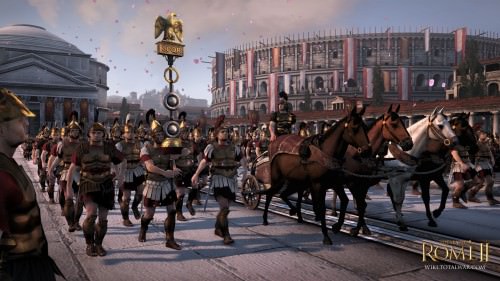
Roman Victory Procession
VICTOR'S SPOILS
Victory in battle brought new territory, acquired wealth and resources, persuaded enemies to sue for peace and sent a clear message that Rome would defend her frontiers, that she had an insatiable thirst for expansion and provided irrefutable evidence of just how formidable a fighting machine the Romans could present on the battlefield.
In the Republic enemy arms could be burned and offerings made to the gods, especially Mars, Minerva and Vulcan.Victorious commanders returned to Rome as heroes in a grand triumphal procession and there were over 300 of them over the centuries. The triumph was first approved and paid for by the Senate. The commander entered the city riding a chariot in a sumptuous procession which included captives, treasures such as gold and works of art, and even exotic animals from the territory of the victory. He wore purple robes ( toga picta and tunica palmata ) and a crown of laurel, held an ivory sceptre and laurel branch and had a slave standing behind him who held a gold crown over his head and whispered, 'Look behind' ( Respice ) to remind him of the dangers of pride and arrogance. From the Augustan period only emperors could enjoy a triumph but, in any case, the practice became much less frequent.
Victorious commanders also used the spoils of war to beautify Rome, for example, Pompey's theatre, Augustus' forum and Vespasian 's Colosseum. Other architectural celebrations of victory included obelisks and columns but perhaps the most striking monument to Roman military vanity was the triumphal arch, the largest and most decorative being that of Constantine I in Rome.
CONCLUSION
Rome's armed forces were the state's largest single expense but the captured territory, resources, wealth and slaves and the later necessity for frontier defence meant that war was an unavoidable Roman preoccupation. Great successes in battle could be enjoyed but so too, defeats could rock Rome to its foundations as able opponents began to use Rome's winning strategies to their own advantage. Further, as Rome's military prowess became more and more well known it would become increasingly difficult for the Roman military to directly engage the enemy. However, over many centuries and across three continents, the Romans had demonstrated that a well-trained, well-disciplined military, if fully exploited by gifted commanders, could reap vast rewards and it would not be until a millennium after its fall that warfare would return to the scale and professionalism that Rome had brought to the field of combat.
Ancient Greek Warfare › Ancient History
Definition and Origins

In the ancient Greek world, warfare was seen as a necessary evil of the human condition. Whether it be small frontier skirmishes between neighbouring city -states, lengthy city-sieges, civil wars, or large-scale battles between multi-alliance blocks on land and sea, the vast rewards of war could outweigh the costs in material and lives. Whilst there were long periods of peace and many examples of friendly alliances, the powerful motives of territorial expansion, war booty, revenge, honour, and the defence of liberty ensured that throughout the Archaic and Classical periods the Greeks were regularly engaged in warfare both at home and abroad.
CITY-STATE RIVALRIES
Evolving from armed bands led by a warrior leader, city militia of part-time soldiers, providing their own equipment and perhaps including all the citizens of the city-state or polis, began to move warfare away from the control of private individuals and into the realm of the state. Assemblies or groups of elite citizens sanctioned war, and generals ( strategoi ) came to be accountable for their actions and were often elected for fixed terms or specific military operations.
In the early stages of Greek Warfare in the Archaic period, training was haphazard and even weapons could be makeshift, although soldiers were usually paid, if only so that they could meet their daily needs. There were no uniforms or insignia and as soon as the conflict was over the soldiers would return to their farms. By the 5th century BCE the military prowess of Spartaprovided a model for all other states to follow. With their professional and well-trained full-time army dressed in red cloaks and carrying shields emblazoned with the letter lambda (for Lacedaemonians), the Spartans showed what professionalism in warfare could achieve.
WARFARE MOVED AWAY FROM ONE-OFF BATTLES FOUGHT IN A FEW HOURS TO LONG-DRAWN-OUT CONFLICTS WHICH COULD LAST FOR YEARS.
Many states such as Athens, Argos, Thebes, and Syracuse began to maintain a small professional force ( logades or epilektoi ) which could be augmented by the main citizen body if necessary. Armies became more cosmopolitan with the inclusion of resident foreigners, slaves, mercenaries, and neighbouring allies (either voluntary or through compulsion in the case of Sparta's perioikoi ). Warfare moved away from one-off battles fought in a few hours to long-drawn-out conflicts which could last for years, the most important being the Persian Wars (first half of the 5th century BCE), the Peloponnesian Wars (459-446 & 431-404 BCE), and the Corinthian Wars (394-386 BCE).
THE HOPLITE PHALANX
The mainstay of any Greek army was the hoplite. His full panoply was a long spear, short sword, and circular bronze shield and he was further protected, if he could afford it, by a bronze helmet (with inner padding for comfort), bronze breastplate, greaves for the legs and finally, ankle guards. Fighting was at close-quarters, bloody, and lethal. This type of warfare was the perfect opportunity for the Greek warrior to display his manliness ( andreia ) and excellence ( aretē ) and generals led from the front and by example.

Greek Hoplites
To provide greater mobility in battle the hoplite came to wear lighter armour such as a leather or laminated linen corselet ( spolades ) and open-faced helmet ( pilos ). The peltast warrior, armed with short javelins and more lightly-armoured than the hoplite became a mobile and dangerous threat to the slower moving hoplites. Other lighter-armed troops ( psiloi ) also came to challenge the hoplite dominance of the battlefield. Javelin throwers ( akonistai ), archers ( toxotoi ) and slingers ( sphendonētai) using stones and lead bullets could harry the enemy with attacks and retreats. Cavalry ( hippeis ) was also deployed but due to the high costs and difficult terrain of Greece, only in limited numbers eg, Athens, possessing the largest cavalry force during the Peloponnesian Wars had only 1,000 mounted troops. Decisive and devastating cavalry offensives would have to wait until the Macedonians led by Philip and Alexander in the mid-4th century BCE.
THE PHALANX WAS A LINE OF WELL-ARMED & WELL-ARMOURED HOPLITE SOLDIERS USUALLY 8-12 MEN DEEP WHICH ATTACKED AS A TIGHT GROUP.
Armies also became more structured, split into separate units with hierarchies of command. The lochoi was the basic unit of the phalanx - a line of well-armed and well-armoured hoplite soldiers usually eight to twelve men deep which attacked as a tight group. In Athens the lochos was led by a captain ( lochagos ) and these combined to form one of ten regiments ( taxeis ) each led by a taxiarchos. A similar organisation applied to the armies of Corinth, Argos, and Megara. In 5th century Sparta the basic element was the enomotiai (platoon) of 32 men. Four of these made up a pentekostys (company) of 128 men. Four of these made up a lochos (regiment) of 512 men. A Spartan army usually consisted of five lochoi with separate units of non-citizen militia -- perioikoi. Units might also be divided by age or speciality in weaponry and, as warfare became more strategic, these units would operate more independently, responding to trumpet calls or other such signals mid-battle.
WAR AT SEA: THE TRIREME
Some states such as Athens, Aegina, Corinth, and Rhodes amassed fleets of warships, most commonly the trireme, which could allow these states to forge lucrative trading partnerships and deposit troops on foreign territory and so establish and protect colonies. They could even block enemy harbours and launch amphibious landings. The biggest fleet was at Athens, which could amass up to 200 triremes at its peak, and which allowed the city to build and maintain a Mediterranean-wide empire.

Greek Trireme
The trireme was a light wooden ship, highly manoeuvrable and fitted with a bronze battering ram at the bow which could disable enemy vessels. Thirty-five metres long and with a 5 metre beam, some 170 rowers ( thetes - drawn from the poorer classes) sitting on three levels could propel the ship up to a speed of 9 knots. Also on board were small contingents of hoplites and archers, but the principal tactic in naval warfare was ramming not boarding. Able commanders arranged their fleets in a long front so that it was difficult for the enemy to pass behind ( periplous ) and ensure his ships were sufficiently close to prevent the enemy going through a gap ( diekplous ). Perhaps the most famous naval battle was Salamis in 480 BCE when the Athenians were victorious against the invading fleet of Xerxes.
However, the trireme had disadvantages in that there was no room for sleeping quarters and so ships had to be dry-docked each night, which also prevented the wood becoming water-logged. They were also fantastically expensive to produce and maintain; indeed the trireme was indicative that now warfare had become an expensive concern of the state, even if rich private citizens were made to fund most of the expense.
BATTLE STRATEGIES
The first strategy was actually employed before any fighting took place at all. Religion and ritual were important features of Greek life, and before embarking on a campaign, the will of the gods had to be determined. This was done through the consultation of oracles such as that of Apollo at Delphi and through animal sacrifices ( sphagia ) where a professional diviner ( manteis ) read omens ( ta hiera ), especially from the liver of the victim and any unfavourable signs could certainly delay the battle. Also, at least for some states like Sparta, fighting could be prohibited on certain occasions such as religious festivals and for all states during the great Panhellenic games (especially those at Olympia ).
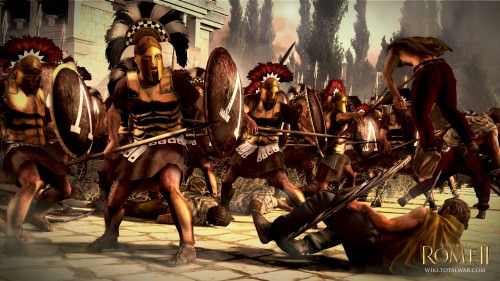
Spartan Warriors
When all of these rituals were out of the way, fighting could commence but even then it was routine to patiently wait for the enemy to assemble on a suitable plain nearby. Songs were sung (the paian - a hymn to Apollo) and both sides would advance to meet each other. However, this gentlemanly approach in time gave way to more subtle battle arrangements where surprise and strategy came to the fore. What is more, conflicts also became more diverse in the Classical period with sieges and ambushes, and urban fighting becoming more common, for example at Solygeia in 425 BCE when Athenian and Corinthian hoplites fought house to house.
Strategies and deception, the 'thieves of war' ( klemmata ), as the Greeks called them, were employed by the more able and daring commanders. The most successful strategy on the ancient battlefield was using hoplites in a tight formation called the phalanx. Each man protected both himself and partially his neighbour with his large circular shield, carried on his left arm.Moving in unison the phalanx could push and attack the enemy whilst minimising each man's exposure. Usually eight to twelve men deep and providing the maximum front possible to minimise the risk of being outflanked, the phalanx became a regular feature of the better-trained armies, particularly the Spartans. Thermopylae in 480 BCE and Plataea in 479 BCE were battles where the hoplite phalanx proved devastatingly effective.
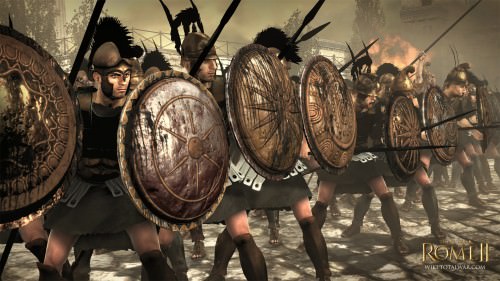
Greek Phalanx
At the Battle of Leuktra in 371 BCE Theban general Epaminondas greatly strengthened the left flank of his phalanx to about 50 men deep which meant he could smash the right flank of the opposing Spartan phalanx, a tactic he used again with great success at Mantineia in 362 BCE. Epaminondas also mixed lighter armed troops and cavalry to work at the flanks of his phalanx and harry the enemy. Hoplites responded to these developments in tactics with new formations such as the defensive square ( plaision ), used to great effect (and not only in defence) by Spartan general Brasidas in 423 BCE against the Lyncestians and again by the Athenians in Sicily in 413 BCE. However, the era of heavily armoured hoplites neatly arranged in two files and slashing away at each other in a fixed battle was over. More mobile and multi-weapon warfare now became the norm. Cavalry and soldiers who could throw missiles might not win battles outright but they could dramatically affect the outcome of a battle and without them the hoplites could become hopelessly exposed.
SIEGES WERE USUALLY LONG-DRAWN-OUT AFFAIRS WITH THE PRINCIPAL STRATEGY BEING TO STARVE THE ENEMY INTO SUBMISSION.
SIEGE WARFARE
From an early stage, most Greek city-states had a fortified acropolis (Sparta and Elis being notable exceptions) to protect the most important religious and civic buildings and provide refuge from attack. However, as warfare became more mobile and moved away from the traditional hoplite battle, cities sought to protect their suburbs with fortification walls. Independent lookout towers in the surrounding countryside and even frontier forts and walls sprang up in response to the increased risk of attacks. Many poleis also built fortifications to create a protective corridor between the city and their harbour, the most famous being the Long Walls which spanned the 7 km between Athens and Piraeus.
Sieges were usually long-drawn-out affairs with the principal strategy being to starve the enemy into submission. Offensive strategies using battering rams and ramps proved largely unsuccessful. However, from the 4th century BCE technical innovations gave the attackers more advantages. Wheeled siege towers, first used by the Carthaginians and copied by Dionysius I of Syracuse against Motya in 397 BCE, bolt-throwing artillery ( gastraphetes ), stone throwing apparatus ( lithoboloi) and even flame-throwers (at Delion in 424 BCE) began a trend for commanders to be more aggressive in siege warfare.However, it was only with the arrival of torsion artillery from 340 BCE, which could propel 15 kg stones over 300 metres, that city walls could now be broken down. Naturally, defenders responded to these new weapons with thicker and stronger walls with convex surfaces to better deflect missiles.
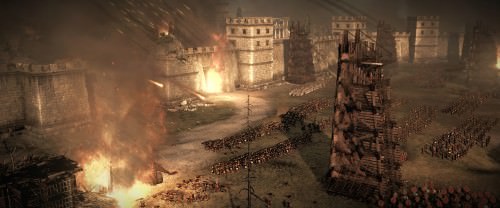
Siege Warfare
LOGISTICS: BAGGAGE & SUPPLIES
The short duration of conflicts in the Greek world was often because of the poor logistics supplying and maintaining the army in the field. Soldiers were usually expected to provide their own rations (dried fish and barley porridge being most common) and the standard for Athens was three-days' worth. Most hoplites would have been accompanied by a slave acting as a baggage porter ( skeuophoroi ) carrying the rations in a basket ( gylion ) along with bedding and a cooking pot. Slaves also acted as attendants to the wounded as only the Spartan army had a dedicated medical officer ( iatroi ). Fighting was usually in the summer so tents were rarely needed and even food could be pillaged if the fighting was in enemy territory. Towards the end of the Classical period armies could be re-supplied by ship and larger equipment could be transported using wagons and mules which came under the responsibility of men too old to fight.
SPOILS OF VICTORY
War booty, although not always the primary motive for conflict, was certainly a much-needed benefit for the victor which allowed him to pay his troops and justify the expense of the military campaign. Booty could come in the form of territory, money, precious materials, weapons, and armour. The losers, if not executed, could expect to be sold into slavery, the normal fate for the women and children of the losing side. It was typical for 10% of the booty (a dekaten ) to be dedicated in thanks to the gods at one of the great religious sanctuaries such as Delphi or Olympia. These sites became veritable treasuries and, effectively, museums of weapons and armour. They also became too tempting a target for more unscrupulous leaders in later times, but still the majority of surviving military material comes from archaeological excavations at these sites.
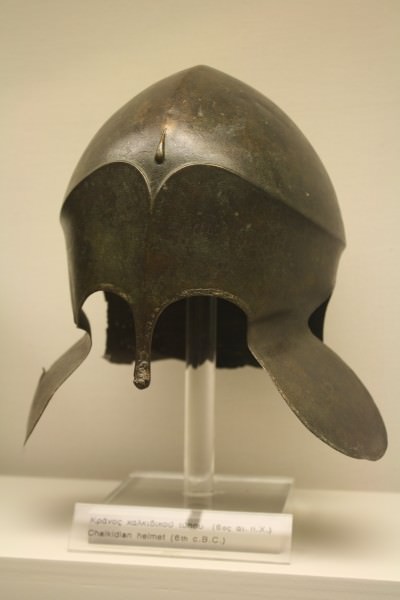
Chalcidian Helmet
Important rituals had to be performed following victory which included the recovering of the dead and the setting up of a victory trophy (from tropaion, meaning turning point in the conflict) at the exact place on the battlefield where victory became assured.The trophy could be in the form of captured weapons and armour or an image of Zeus ; on occasion memorials to the fallen were also set up. Speeches, festivals, sacrifices and even games could also be held following a victory in the field.
CONCLUSION
Greek warfare, then, evolved from small bands of local communities fighting for local territory into massive set-piece battles between multi-allied counterparts. War became more professional, more innovative, and more deadly, reaching its zenith with the Macedonian leaders Philip and Alexander. Learning from the earlier Greek strategies and weapons innovations, they employed better hand weapons such as the long sarissa spear, used better artillery, successfully marshalled diverse troop units with different arms, fully exploited cavalry, and backed all this up with far superior logistics to dominate the battlefield not only in Greece but across vast swathes of Asia and set the pattern for warfare through Hellenistic and into Roman times.
LICENSE:
Article based on information obtained from these sources:with permission from the Website Ancient History Encyclopedia
Content is available under License Creative Commons: Attribution-NonCommercial-ShareAlike 3.0 Unported. CC-BY-NC-SA License